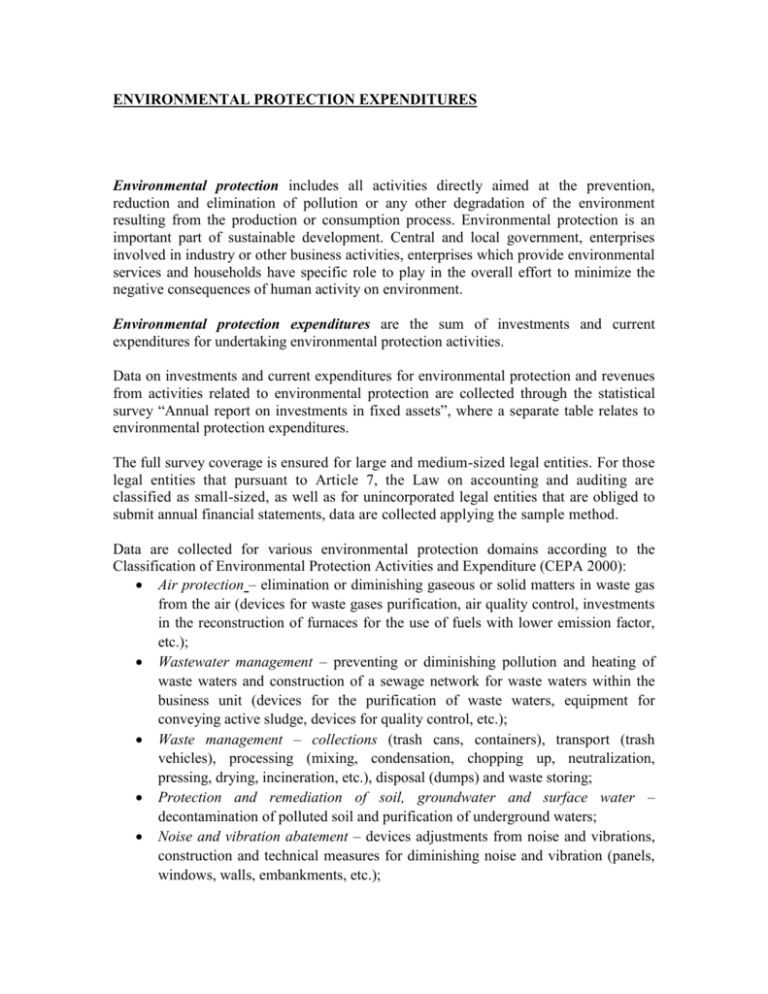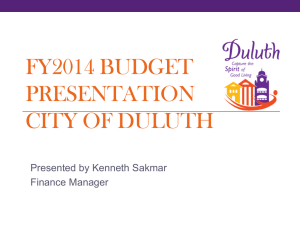ENVIRONMENTAL PROTECTION EXPENDITURES
advertisement

ENVIRONMENTAL PROTECTION EXPENDITURES Environmental protection includes all activities directly aimed at the prevention, reduction and elimination of pollution or any other degradation of the environment resulting from the production or consumption process. Environmental protection is an important part of sustainable development. Central and local government, enterprises involved in industry or other business activities, enterprises which provide environmental services and households have specific role to play in the overall effort to minimize the negative consequences of human activity on environment. Environmental protection expenditures are the sum of investments and current expenditures for undertaking environmental protection activities. Data on investments and current expenditures for environmental protection and revenues from activities related to environmental protection are collected through the statistical survey “Annual report on investments in fixed assets”, where a separate table relates to environmental protection expenditures. The full survey coverage is ensured for large and medium-sized legal entities. For those legal entities that pursuant to Article 7, the Law on accounting and auditing are classified as small-sized, as well as for unincorporated legal entities that are obliged to submit annual financial statements, data are collected applying the sample method. Data are collected for various environmental protection domains according to the Classification of Environmental Protection Activities and Expenditure (CEPA 2000): Air protection – elimination or diminishing gaseous or solid matters in waste gas from the air (devices for waste gases purification, air quality control, investments in the reconstruction of furnaces for the use of fuels with lower emission factor, etc.); Wastewater management – preventing or diminishing pollution and heating of waste waters and construction of a sewage network for waste waters within the business unit (devices for the purification of waste waters, equipment for conveying active sludge, devices for quality control, etc.); Waste management – collections (trash cans, containers), transport (trash vehicles), processing (mixing, condensation, chopping up, neutralization, pressing, drying, incineration, etc.), disposal (dumps) and waste storing; Protection and remediation of soil, groundwater and surface water – decontamination of polluted soil and purification of underground waters; Noise and vibration abatement – devices adjustments from noise and vibrations, construction and technical measures for diminishing noise and vibration (panels, windows, walls, embankments, etc.); Protection of biodiversity and landscape – protection against erosion and flood, as well as protection of legally protected flora and fauna species, etc.; Other environmental protection activities – research and development, protection against radiation, environmental management, education, training and information, as activities not elsewhere classified. Environmental protection investments include all capital expenditures relating to environmental protection activities (involving methods, technologies, processes, equipment or parts thereof), where the main purpose is to collect, treat, monitor and control, reduce, prevent, or eliminate pollutants and pollution or any other degradation of the environment resulting from the operating activity of the business. Environment protection investments are divided as follows: Pollution treatment investments (end-of-pipe investments) – investments for the new methods, technologies and/or equipment designed to collect and remove the pollution and pollutants after their creation, also to treat and dispose of pollutants and to monitor and measure the level of pollution. Pollution prevention investments (investments in integrated technologies) – investments for new or adaptation of existing methods, technologies and/or equipment designed to prevent or reduce the amount of pollution created at the source, i.e. within production process (replacement of existing raws for cleaner, waste use in production process as secondary raw material, provisions of equipment and tools needed to abate noise and vibrations, etc.). Current expenditures for environmental protection include labour costs, payments of rents, use of energy and other material goods and purchases of services, where the main purpose is to prevent, reduce, treat or eliminate pollutants and pollution or any other degradation of the environment resulting from the operating activity of the business. Current expenditures for environmental protection are divided into: Current expenditures within the reporting unit (internal current expenditures) – operation and maintenance of environmental protection facilities (use of material and energy), labour costs (only employees who are involved in activities related to environmental protection), and other internal current expenditures (education, information, general administration and other expenditures related to environmental protection, etc.). Current expenditures paid to third parties for environmental protection services (external current expenditures) – payments to third parties (public sector and specialised producers) for environmental protection services – waste collection, wastewater treatment, monitoring by authorized institutions, expenditures for soil decontamination, etc. Payments of taxes directly used for financing environmental protection expenditure – so called "ear-marked" environmental taxes and penalties are not reported here. Expenditures for health and safety at work are excluded from current expenditures for environment protection. Apart from expenditures, data on revenues from environmental protection related activities are collected. Revenues from environmental protection related activities are divided into: Revenues from providing environmental protection services – revenues from environmental protection services (collection of waste, waste water cleaning/treatment, soil decontamination, etc). Receipts from sales of by-products that are the result of the environmental protection activities – revenues from sales of electricity generated as a product of the degassing process in waste, sales revenue of waste that is used as secondary raw material, etc. Revenues from internal use of by-products resulting from activities related to environmental protection (estimated savings due to internal use of by-products) – the value of waste used as secondary raw material in the reporting unit, etc. For the calculation of expenditures for environmental protection, other data sources are also used – National accounts data, data of financial statements, the results of the survey "Structure of income and expenditure of economic subjects in the Republic of Serbia", data on number of employees and data of the survey "Annual Report on research and development." In recent years, monitoring the impact of various elements of the environment has got increasing importance. In line with this, as well as to achieve harmonization with international requirements and standards in this field, the published data on expenditures for environmental protection for the period 2006-2012 were revised. Data sources and coverage are significantly improved and expanded, which resulted in the better quality of published data.







